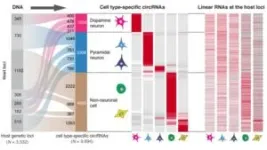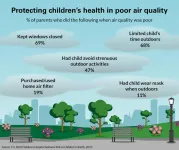(Press-News.org) Investigators found and catalogued mysterious RNA circles that are linked to brain cell identity
Findings show that circular RNA is produced by brain cells damaged in Parkinson’s and Alzheimer’s disease
Circular RNA production from one Parkinson’s gene DNAJC6 was abnormal even prior to symptom onset
Researchers are gaining new insights into neurological diseases by studying circular RNAs (circRNAs) in brain cells. A new study by investigators from the Brigham and Women’s Hospital, a founding member of the Mass General Brigham healthcare system, identified over 11,000 distinct RNA circles that characterized brain cells implicated in Parkinson’s disease and Alzheimer’s disease. Their results are published in Nature Communications.
“Circular RNA has long been cast aside as junk, but we believe it has an important role in programming human brain cells and synapses,” said corresponding author Clemens Scherzer, MD, of the Department of Neurology and the American Parkinson Disease Association Center for Advanced Parkinson Research at Brigham. “We found that these circular RNAs were produced in large quantities by brain cells, including those associated with Parkinson’s and Alzheimer’s.”
Scherzer and colleagues laser-captured neurons from 190 frozen postmortem human brain samples, including some non-neuronal cells for comparison. Then, they used ultra-deep, total RNA sequencing to study the exact sequences of genetic code found in the circular RNAs within these two cell types.
They found that 61% of all synaptic circRNAs they characterized were associated with brain disorders. Notably, they found 4,834 cell-type specific circular RNAs in dopamine and pyramidal neurons, two highly functioning brain cells. Dopamine neurons control movement, mood, and motivation while pyramidal neurons play an important role in memory and language.
“It was surprising that the circular RNAs rather than the linear RNAs produced from these gene locations defined neuron identity,” said the first author Xianjun Dong, PhD, an assistant professor in the Department of Neurology and the Genomics and Bioinformatics Hub at the Brigham. “circRNA diversity provides finely tuned, cell type-specific information that is not explained by the corresponding linear RNAs from the same gene.”
Degeneration of these dopamine and pyramidal neurons plays a key role in the development of neurological disorders. When researchers investigated this connection further, they found that a surprising number of Parkinson's and Alzheimer's genes produced circular RNA. For example, expression of one circRNA produced from the Parkinson’s gene DNAJC6 was reduced in vulnerable dopamine neurons even prior to symptom onset.
“Naturally occurring circRNAs have the potential to serve as biomarkers for specific brain cells implicated in early, prodromal stages of a disease,” Scherzer said. “Circular RNAs cannot easily be broken down, making them a powerful tool as reporters and for delivering therapies. They could be rewritten synthetically and harnessed as future digital RNA medicines.”
The team identified that genes associated with different diseases produced circRNAs in particular cell types. For example, addiction-associated genes gave rise to circRNAs in dopamine neurons, autism-associated genes in pyramidal neurons, and cancer associated genes in non-neuronal cells.
Limitations of the current study include an incomplete understanding of how this complex RNA machinery specifies neuron and synapse identity. Future research can investigate how these circRNAs arise and function and survey additional genetic regulators that govern their behavior.
Still, current findings provide the most comprehensive analysis of circRNAs in human brain cells to-date and suggest they can be leveraged for RNA diagnostics and medicines used to treat neurological conditions.
“The discovery of circular RNAs changes our understanding of the molecular mechanisms behind neurodegenerative disorders,” Dong said. “Circular RNAs are much more durable than linear RNAs and hold promise as RNA therapies and RNA biomarkers.”
Disclosures: Scherzer has served as consultant, scientific collaborator or on scientific advisory boards for Sanofi, Berg Health, Pfizer, Biogen, and has received grants from National Institute of Health (NIH), U.S. Department of Defense, American Parkinson Disease Association (APDA), Aligning Science Across Parkinson’s (ASAP), and The Michael J. Fox Foundation. Dong has received funding from NIH, APDA, and ASAP.
Funding: This study was funded in part by the American Parkinson Disease Association, NIH, and the U.S. Department of Defense, with additional contributions from the ASAP Foundation.
Paper cited: Dong X et al. “Circular RNAs in the human brain are tailored to neuron identity and neuropsychiatric disease.” Nature Communications. DOI: 10.1038/s41467-023-40348-0
END
A new study published in a Nature Partner Journal, npj Microgravity, finds an engineered compound given to mice aboard the International Space Station (ISS) largely prevented the bone loss associated with time spent in space. The study, led by a transdisciplinary team of professors at the University of California at Los Angeles (UCLA) and the Forsyth Institute in Cambridge, Massachusetts, highlight a promising therapy to mitigate extreme bone loss from long-duration space travel as well as musculoskeletal ...
Javier Ramón Azcón, an ICREA research professor and the leader of the Biosensors for Bioengineering group at the Institute for Bioengineering of Catalonia (IBEC), has been granted an "ERC Proof of Concept Grant." This prestigious grant is awarded by the European Research Council (ERC) and aims to explore the commercial and societal potential of research projects that have been previously funded by the ERC. Recipients use this type of funding to verify the practical viability of scientific concepts, explore business opportunities or prepare patent applications.
Ramón's project has been named "Uniink" and centers ...
ANN ARBOR, Mich. – As smoke from Canada's historic wildfires triggers poor air quality alerts across the country, many parents worry about the impact on their child’s health, a new national poll suggests.
Two-thirds of parents say over the past two years they have experienced at least one day with poor or unhealthy air quality in their area, according to the University of Michigan Health C.S. Mott Children’s Hospital National Poll on Children’s Health.
In response to poor air quality alerts, most parents kept their windows closed and limited ...
It's no longer just about stopping, but how we can live with climate change. To figure this out, we must delve into our cultures, as highlighted in a special issue of The Royal Society. A study by the Complexity Science Hub points out how our history could help guide the way.
Currently, we are grappling with a global crisis convergence. Various types of threats intersect, intertwine, and test our collective resilience, from climate change and economic inequality to political polarization. Although the scale and global reach of these challenges present new hurdles, these threats have been faced and, sometimes, overcome in the past. Societies today ...
All animals have an internal clock called a circadian clock, which is regulated by cues from their environment — but animals in zoos can be exposed to very different cues from animals in the wild. Since all animals’ circadian clocks are linked to their behavior and physiology, this could be significant to their welfare, which is crucial to maintaining captive populations of animals at high risk of extinction in the wild, like giant pandas. Scientists set out to understand how the ‘jet lag’ of living ...
Developed in 2011, MXene is a two-dimensional nanomaterial with alternating metal and carbon layers, which has high electrical conductivity and can be combined with various metal compounds, making it a material that can be utilized in various industries such as semiconductors, electronic devices, and sensors. To properly utilize MXene, it is important to know the type and amount of molecules covered on the surface, and if the molecules covered on the surface are fluorine, the electrical conductivity of decreases and the efficiency of electromagnetic wave shielding decreases. However, since it is only 1 nm (nanometer - billionth of a meter) thick, ...
Researchers from the University of Waterloo completed the first-ever assessment of a Canadian hospital to reveal its total environmental footprint and specific carbon emission hotspots.
Studying a hospital in British Columbia during its 2019 fiscal year, the researchers identified energy and water use and purchasing of medical products as the hospital’s primary hotspots, accounting for over half of the yearly footprint, totalling 3500-5000 tons of CO2 equivalent. One hospital bed is roughly equivalent to the carbon footprint of five Canadian households.
The new method brings an unprecedented level of comprehensiveness and detail to hospital ...
The early treatment of obesity in children is effective in both the short and long term, researchers from Karolinska Institutet report in a study published in The International Journal of Obesity.
The researchers followed over 170 young children in Sweden who had received treatment for diagnosed obesity. The children were recruited to the randomised controlled study when they were between four and six years old via children’s clinics in Region Stockholm.
The children and their parents were randomly assigned to one of three treatment conditions: standard treatment, parental support group, or parental support group with follow-up telephone ...
In a sign that exposure to certain endocrine-disrupting chemicals may be playing a role in cancers of the breast, ovary, skin and uterus, researchers have found that people who developed those cancers have significantly higher levels of these chemicals in their bodies.
While it does not prove that exposure to chemicals like PFAS (per- and poly-fluoroalkyl substances) and phenols (including BPA) led to these cancer diagnoses, it is a strong signal that they may be playing a role and should be studied further.
The study showed that particularly for women, higher ...
Museums and Societal Collapse: The Museum as Lifeboat presents evidence and theories around collapse and extinction, while locating the responsibility of museums in our changing world
Stressors like climate trauma, corporate deceit and political incompetence signal the threat of societal collapse, a new book asserts.
This claim lays the foundation for exploring arguments of ‘collapsology’ in new work by Robert R. Janes Ph.D., Museums and Societal Collapse: The Museum as Lifeboat. The book also contends with the unique role that can be played by museums during a mounting climate crisis.
“Social ...






